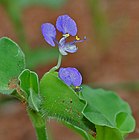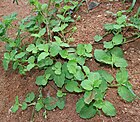Note: This is a project under development. The articles on this wiki are just being initiated and broadly incomplete. You can Help creating new pages.
Commelina benghalensis
Commelina benghalensis is a herbaceous perennial plant. The plant can become annual in areas with colder winters or long dry seasons.
Uses
Parts Used
Chemical Composition
Phytochemicals are present in plant have healing properties. C. diffusa contain minerals, vitamins, alkaloids, saponins, phenols, tannins, phytosterols, triterpens, terpenoids as secondary metabolites. Plants produce diverse array of low molecular weight products. These phytochemicals are responsible for pharma industry and at higher concentration toxic to animals. [2]
Common names
| Language | Common name |
|---|---|
| Kannada | ಗುಬ್ಬಚ್ಚಿ ಬಾಳೆ Gubbachchi bale, ಗುಬ್ಬಚ್ಚಿ ಬಸಳೆ Gubbachchi basale |
| Hindi | Jalbhu, Kanakaua |
| Malayalam | Kanavazhai, Vuzhaipadathi |
| Tamil | Kan-an-kolai, Kanavalai |
| Telugu | Amruta kaada, Neerukaassuvu |
| Marathi | Kanchat, Kena |
| Gujarathi | Motun shishmuliyun |
| Punjabi | NA |
| Kashmiri | NA |
| Sanskrit | Kanchata |
| English | Bengal dayflower, Fire leaf |
Properties
Reference: Dravya - Substance, Rasa - Taste, Guna - Qualities, Veerya - Potency, Vipaka - Post-digesion effect, Karma - Pharmacological activity, Prabhava - Therepeutics.
Dravya
Rasa
Guna
Veerya
Vipaka
Karma
Prabhava
Habit
Identification
Leaf
| Kind | Shape | Feature |
|---|---|---|
Flower
| Type | Size | Color and composition | Stamen | More information |
|---|---|---|---|---|
| Flowering from June to December |
Fruit
| Type | Size | Mass | Appearance | Seeds | More information |
|---|---|---|---|---|---|
| Fruiting from June to December |
Other features
List of Ayurvedic medicine in which the herb is used
Where to get the saplings
Mode of Propagation
How to plant/cultivate
A plant of warm temperate to tropical areas where it can be found at elevations up to 1,600 metres.[5]
Commonly seen growing in areas
Photo Gallery
References
- ↑ Karnataka Medicinal Plants Volume - 2 by Dr.M. R. Gurudeva, Page No. 159
- ↑ [Chemistry]
- ↑ Common names
- ↑ [Morphology]
- ↑ Cultivation
External Links
- Ayurvedic Herbs known to be helpful to treat Eye ailments
- Ayurvedic Herbs known to be helpful to treat Sore throat
- Ayurvedic Herbs known to be helpful to treat Burns
- Ayurvedic Herbs known to be helpful to treat Sorefeet
- Ayurvedic Herbs known to be helpful to treat Diarrhoea
- Ayurvedic Herbs known to be helpful to treat Constipation
- Ayurvedic Herbs known to be helpful to treat Increase the sperm count
- Herbs with Leaves used in medicine
- Herbs with common name in Kannada
- Herbs with common name in Hindi
- Herbs with common name in Malayalam
- Herbs with common name in Tamil
- Herbs with common name in Telugu
- Herbs with common name in Marathi
- Herbs with common name in Gujarathi
- Herbs with common name in Sanskrit
- Herbs with common name in English
- Habit - Perennial
- Index of Plants which can be propagated by Stem cuttings
- Index of Plants which can be propagated by Root cuttings
- Index of Plants which can be propagated by Seeds
- Herbs that are commonly seen in the region of Common in disturbed areas
- Herbs that are commonly seen in the region of At forest edges
- Herbs that are commonly seen in the region of Home gardens
- Herbs that are commonly seen in the region of Secondary regrowth
- Herbs
- Pages without herbs images







